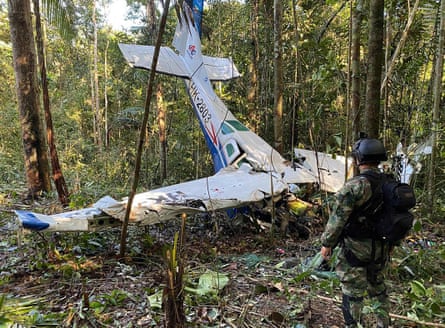A few tantalising clues kept the rescuers going. The remains of fruit with bitemarks made by small human teeth, a pair of scissors and nappies in the rainforest mud. All offered hope that four children, who had miraculously survived a plane crash that killed their mother, the pilot and the only other adult on board, also survived the dangers of the Amazon.
The oldest was only 13 when the plane went down on 1 May in southern Colombia. The youngest would mark his first birthday lost under the dense green canopy of trees and vegetation, alive with jaguars, venomous snakes and other threats.
The children are Lesly Jacobo Bonbaire, 13; Solecni Ranoque Mucutuy, 9; Tien Noriel Ronoque Mucutuy, 4; and Cristian Neryman Ranoque Mucutuy, now one.
The remains of the Cessna light aircraft were found two weeks later, with the bodies of three adults still inside. But there was no sign of the children, who come from the Huitoto Indigenous community. A long search through the virgin, inhospitable forest began.

Helicopters hovered over the area around the crash, broadcasting messages from the children’s grandmother, telling them they hadn’t been forgotten, urging them to stay in one place, and dropping packets of food that may have helped them survive. In the middle of May, the children’s father also joined the hunt.
The rescue effort, Operation Hope, ramped up rapidly, eventually encompassing 150 soldiers and 200 volunteers from local Indigenous communities and a team of 10 Belgian shepherd dogs, covering an area of more than 323 sq km (125 sq miles). The search continues for Wilson, one of the dogs who disappeared during the operation.
As the days stretched into weeks, and the weeks into a second month, some in Colombia began to wonder if they were deluding themselves.
Some of the rescuers went home, a combined command headquarters was dismantled. But a little more than a week before their discovery, Brigadier General Pedro Sanchez said he was convinced the children were alive, because bodies would be easier to find than a small group who were moving through the forest.
“This isn’t a search for a needle in a haystack, it’s a tiny flea in a vast carpet, because they keep moving,” he told Colombian journalists. “Their bodies haven’t appeared, and I’m sure that we would have already found them if they were dead.”
Then on Friday, about 4pm local time, army radios crackled into life. “Miracle, miracle, miracle, miracle”. It was the army code for a child found alive; repeated four times it meant all four had survived, in a remarkable feat of resilience.
Although malnourished, and covered in insect bites, none were in a serious condition. The military tweeted pictures of a group of soldiers and volunteers posing with the children, who were wrapped in thermal blankets, surrounded by the team that found them, with Cristian cradled in the arms of a rescuer.

“They’ve given us an example of total survival that will go down in history,” said Colombia’s president, Gustavo Petro, calling it “a joy for the whole country”.
The education the children got from their grandmother, a respected elder in the Araracuara indigenous territory, was almost certainly vital to their survival.
“This is a virgin forest, thick and dangerous,” John Moreno, an Indigenous leader from nearby Vaupés, told local media outlet Cambio.
“They would have needed to draw on ancestral knowledge, in order to survive.”
In addition to evading jungle predators, the children had survived heavy storms, and the area also hosts armed groups.
Sanchez said rescue teams had covered more than 2,600km (1,600 miles) on foot in the search for the children, and described the challenging conditions of their mission.
“The men walked 10 metres apart. In virgin forest, with trees 40 or 50 metres high, where the sun barely reaches the forest floor, a man can lose himself within 20 or 30 metres. If someone is separated, the forest swallows them up,” Sanchez said.

The children were found with rags wrapped around their feet, to protect them as they moved through the muddy forest floor, and rescuers had to winch them up to helicopters as the vegetation was too dense for aircraft to land.
After their initial helicopter evacuation to the town of San José del Guaviare, the children were taken on a military medical plane to Bogotá, where four ambulances were waiting to take them to hospital for specialist care. An uncle and their grandparents are among relatives now waiting to be reunited with the children.
“I thank the president for his help and the Indigenous people who collaborated in the search for our children. I don’t know how to thank them, because the word ‘thank you’ is not enough,” Narcizo Mucutuy, the children’s grandfather, told Caracol TV station.
Rumours initially emerged about the children’s whereabouts on 18 May, when Petro tweeted that the children had been found. He then deleted the message, claiming he had been misinformed by a government agency.
On Friday, after confirming the children had been rescued, the president said that for a while he had believed the children were rescued by one of the nomadic tribes that still roam the remote swathe of the jungle where the plane fell and have little contact with authorities.
But Petro added that the children were first found by one of the rescue dogs that soldiers took into the jungle. He said that he hoped to meet the children on Saturday.
“The jungle saved them,” Petro said. “They are children of the jungle, and now they are also children of Colombia.”